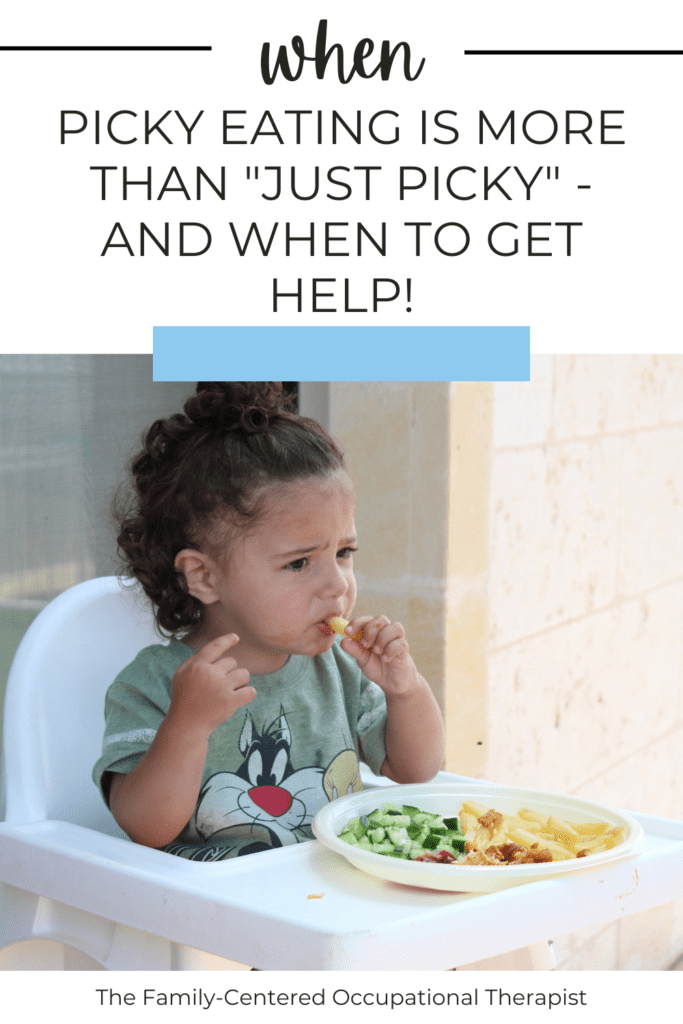Many parents will describe their kids as picky eaters, but there’s a significant difference between what feeding therapists consider picky eaters versus problem feeders. Diagnostically, problem feeders are referred to as having pediatric feeding disorder (note that this is very different than an eating disorder). And while picky eaters can sometimes benefit from feeding therapy, we are most concerned about getting problem feeders into feeding therapy.
How do I know if my child is picky eater or a problem feeder?
Dr. Kay Toomey and her team at the SOS approach to feeding do a fantastic job of breaking this down in their PDF explaining problem feeders vs picky eaters. As a feeding therapist, my general rule of thumb is: if it negatively impacts your family or your child’s quality of life, your child may be a problem feeder.
When I see problem feeders in clinic, they tend to have one or more of the following characteristics. They…
- Have breakdowns when they see a new food
- Have 20 food or less that they will eat. Period.
- In the book, Anxious Eaters, Anxious Mealtimes, Marsha Dunn Klein describes these kids’ food lists as a parenthesis food list. They might eat chicken nuggets, but they won’t just eat any chicken nuggets. On their food list, it looks like: chicken nuggets (certain brand, dinosaur shaped only, served on my red plate).
- Are brand specific
- Only eat at home or in specific environments
- Refuse a whole group of foods based on texture (i.e. chewy foods), appearance, smell, etc.
- Become visibly anxious around mealtime
- Had difficulty latching on as a baby or had difficulty with transitioning from purees to solids
- Have poor growth curve trajectories
“If it negatively impacts your family or your child’s quality of life, your child may be a problem feeder”
Okay, so I think my kid is more of a picky eater than a problem feeder. What now?
If your child is a picky eater, you should closely monitor their progress based on the red flags list above. I suggest working with your child purposefully for a couple months to expand their food repertoire. You can accomplish this through playing, involving them in meal prep, and being creative in what you serve and how you serve it. For suggestions on how to accomplish this, I recommend looking at the following blogs and Instagrams:
Additionally, check out my growing resource list under my “feeding and eating” category. This includes how to help your child “fix” foods to work better for their bodies, and why I don’t require kids to earn their dessert.
My child better fits the description of a problem feeder. What do I do now?
Talk to your child’s pediatrician and ask for a referral to a feeding therapist. Some pediatricians are better informed on problem feeders than others. If you have concerns about talking with your child’s doctor, the resource below from Feeding Matters is a great resource to bring to the appointment.
Don’t panic. I know this is easier said than done, but your child has made it this far. A label will not change who your child is or what they do or do not do or eat.
Do not pressure your child. Keep mealtimes short, pleasant, and make sure to serve plenty of their safe foods. Don’t get caught up in getting them to eat more foods right away, as this will likely cause increased anxiety for you and your child.
Do play with new foods outside of mealtimes. Children learn best through play, and play is a natural anxiety-reducer for kids. If you present a new food at mealtime with pressure to learn about it, your child will likely shut down. But, if that food is presented outside of the mealtime context, there is reduced pressure for your child to eat it. Then, they can feel free to explore and learn about the new food at their own pace. As far as playing with food, check out the resources above under the picky eater suggestions, and keep an eye out for my growing body of resources under the feeding and eating blog posts.
As a rule of thumb, play with foods the way your child plays with anything else. Do they like to dump and fill? Dump and fill cups with new foods. Do they like Paw Patrol? Build a Paw Patrol tower out of new foods. Keep it light, fun, and enticing for you and your child. Have fun!
As always, please feel free to contact me with any questions!



2 thoughts on “When picky eating is more than “just” picky – and when to get help!”
Comments are closed.